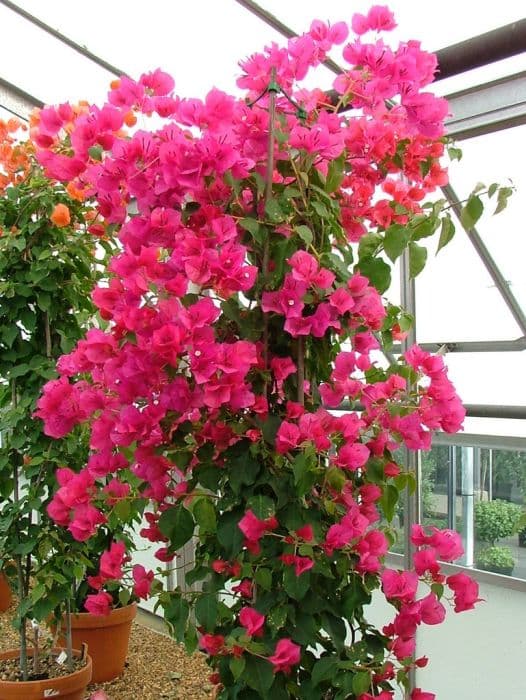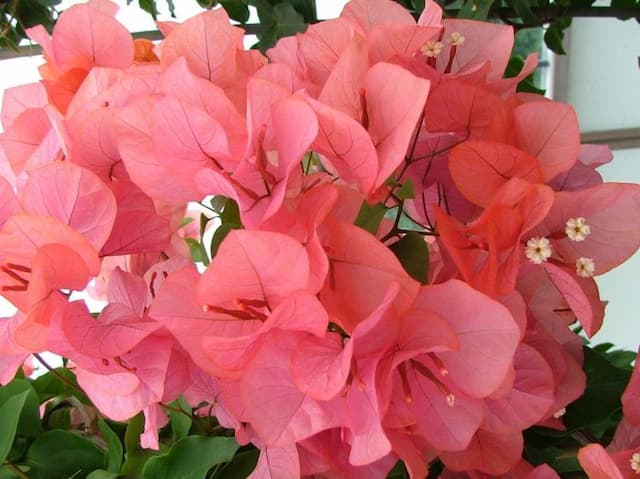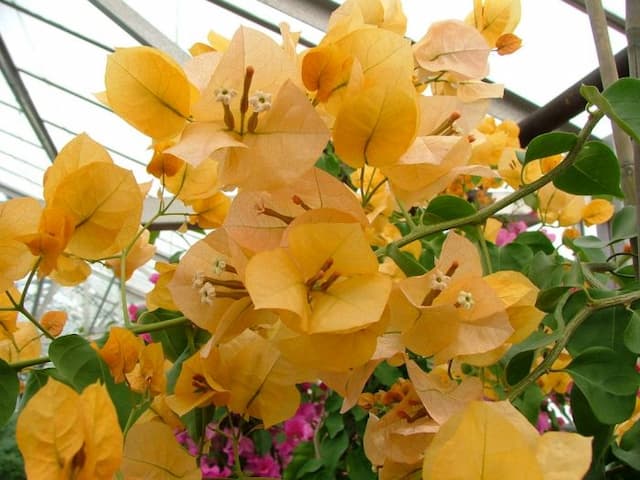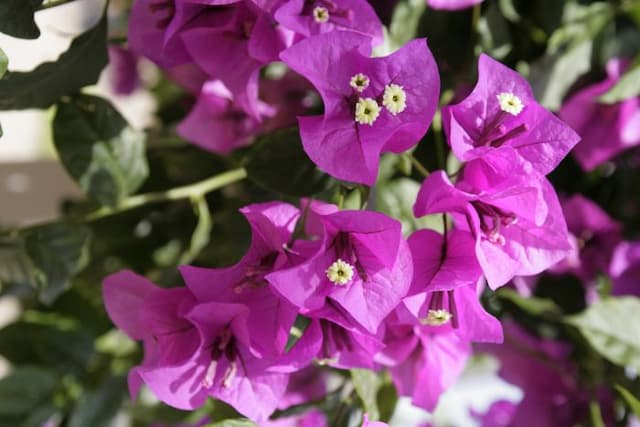Bougainvillea 'San Diego Red' Bougainvillea 'San Diego Red'

ABOUT
'San Diego Red' is a cultivar with pinkish-red bracts. It can tolerate lower temperatures than many other Bougainvillea cultivars
About this plant
 Names
NamesFamily
Nyctaginaceae
Synonyms
San Diego Red Bougainvillea, Scarlet O'Hara
Common names
Bougainvillea spectabilis 'San Diego Red'.
 Characteristics
CharacteristicsLife cycle
Perennials
Foliage type
Evergreen
Color of leaves
Green
Flower color
Red
Height
15-40 feet (4.5-12 meters)
Spread
5-8 feet (1.5-2.4 meters)
Plant type
Climber
Hardiness zones
9-11
Native area
South America
Benefits
 General Benefits
General Benefits- Vibrant Color: The San Diego Red Bougainvillea offers brilliant red blooms that add a pop of color to any landscape.
- Drought Tolerance: Once established, it requires minimal watering, making it ideal for arid climates and water-conservation landscapes.
- Heat Resistance: This variety thrives in hot conditions, perfect for warm-region gardens.
- Fast Growth: It grows quickly, providing rapid coverage for trellises, walls, and fences.
- Easy Maintenance: Requires minimal care, aside from occasional pruning to maintain shape and encourage blooming.
- Year-Round Interest: Evergreen in frost-free areas, it provides consistent foliage and intermittent blooms throughout the year.
- Pest Resistance: Generally resistant to pests, reducing the need for chemical treatments.
- Versatility: Can be grown as a shrub, vine, or groundcover, depending on pruning and training.
 Medical Properties
Medical PropertiesThis plant is not used for medical purposes.
 Air-purifying Qualities
Air-purifying QualitiesThis plant is not specifically known for air purifying qualities.
 Other Uses
Other Uses- Bougainvillea can be used as a natural dye for fabrics, providing a range of pink, magenta, and purple hues depending on the preparation and mordant used.
- Its thorny branches can be incorporated into living fences or barriers, leveraging its dense growth for security and privacy.
- The plant's wood, being quite hard when mature, can be used in the creation of small wooden tools or ornamental objects.
- Its vibrant bracts are sometimes used in the crafting of flower arrangements or potpourri, adding a splash of long-lasting color.
- Bougainvillea leaves can be utilized as a natural pH indicator in science education, turning red in acidic conditions.
- When dried and finely ground, the bracts can be used as a colorant for natural cosmetics, such as blush or eye shadow.
- The plant can be trained into artistic shapes or bonsai forms, making it a focal point for horticultural art and creativity.
- Bougainvillea's aggressive growth can be harnessed for soil erosion control, as they can quickly cover vulnerable slopes with their root systems.
- Bougainvillea sap has been traditionally used as an ingredient in homemade glues and varnishes in some cultures.
- The dense foliage and thorny branches can provide nesting spaces for birds, offering a habitat and protection from predators.
Interesting Facts
 Feng Shui
Feng ShuiThe Bougainvillea is not used in Feng Shui practice.
 Zodiac Sign Compitability
Zodiac Sign CompitabilityThe Bougainvillea is not used in astrology practice.
 Plant Symbolism
Plant Symbolism- Passion: The vivid red color of Bougainvillea 'San Diego Red' is often associated with strong emotions and passion, making it a symbol of intense feeling and enthusiasm.
- Beauty: With its striking appearance and lush, colorful foliage, this plant is symbolic of beauty and visual appeal, representing the idea that true beauty can flourish in tough conditions.
- Survival: Bougainvillea 'San Diego Red' is known for its hardiness and ability to thrive in challenging environments, symbolizing survival, adaptability, and resilience.
- Protection: The plant's thorns are a natural protective mechanism, which can be seen as symbolic of safeguarding and setting boundaries in one's life.
- Welcome: Traditionally, bougainvillea plants are often planted near fences and gates, symbolizing a warm welcome and hospitality towards guests.
 Water
WaterBougainvillea 'San Diego Red', commonly known as Bougainvillea, prefers a deep and infrequent watering regime to encourage a robust root system. During the growing season in the spring and summer, watering approximately once a week with about 1 to 1.5 gallons per plant should suffice, depending on the size and heat. The soil should be allowed to dry out between waterings. In cooler months, reduce the frequency to every 3-4 weeks, watching for the first inch or so of soil to become dry. It's essential not to overwater as Bougainvillea is drought-tolerant and prone to root rot when kept too moist.
 Light
LightBougainvillea thrives best in full sun conditions, ideally receiving more than 6 hours of direct sunlight per day. Place the Bougainvillea in a location where it is bathed in ample sunlight to ensure vibrant blooms and healthy growth. Partial shade is tolerated but may result in less flowering. Indoor plants should be positioned by a sunny window to get the necessary light.
 Temperature
TemperatureThe ideal temperature range for Bougainvillea to flourish is around 65 to 95 degrees Fahrenheit. It can survive minimum cold temperatures down to about 30 degrees Fahrenheit but extended exposure to cold can damage the plant. Bougainvillea favors warmer climates and should be protected from frost to prevent potential damage to the foliage and blooms.
 Pruning
PruningPrune Bougainvillea after it blooms to shape and encourage more flowers since blooms occur on new growth. Typically, pruning is done in late winter or early spring before new growth begins. Remove any dead or damaged wood, and prune sparingly for size, as Bougainvillea blooms best when somewhat pot-bound or stressed. Pruning can be done a couple of times a year to maintain an attractive shape and healthy plant.
 Cleaning
CleaningAs needed
 Soil
SoilBougainvillea 'San Diego Red' prefers well-draining and moderately fertile soil with added perlite or coarse sand for improved drainage. An ideal soil mix is 1 part peat, 1 part pine bark, and 1 part coarse sand or perlite. The optimal soil pH range for Bougainvillea is slightly acidic to neutral, around 5.5 to 6.5.
 Repotting
RepottingSan Diego Red Bougainvillea should be repotted every 2-3 years or when it has outgrown its current container. The best time to repot is in the spring right before the growing season begins.
 Humidity & Misting
Humidity & MistingSan Diego Red Bougainvillea thrives in moderate to high humidity conditions, but it is quite adaptable and can tolerate lower humidity levels as well. Maintaining ambient humidity around 40-60% is generally safe for this plant.
 Suitable locations
Suitable locationsIndoor
Place in bright sunlight, minimal watering, allow soil to dry.
Outdoor
Full sun, well-draining soil, protect from frost.
Hardiness zone
9-11 USDA
 Life cycle
Life cycleBougainvillea 'San Diego Red', commonly known as Bougainvillea, begins its life cycle through seed germination or more commonly through rooted cuttings, which is a faster and more reliable method for this species. Once established, the plant enters a vigorous vegetative growth phase, where it develops a strong root system and extensive vining branches, requiring ample sunlight and warmth to thrive. As it matures, the plant produces its distinctive papery bracts in bright red, which are often mistaken for flowers; the actual flowers are small and white, nestled within the bracts. The flowering stage can occur several times a year in proper growing conditions, particularly during the warmer months. After the flowering stage, the plant may enter a brief dormancy period in cooler climates or may continue growing in regions that remain warm year-round. Throughout its lifetime, Bougainvillea 'San Diego Red' may require periodic pruning to shape the plant and promote more prolific blooming.
 Propogation
PropogationPropogation time
Spring-Early Summer
The most popular method of propagating Bougainvillea 'San Diego Red' is through stem cuttings. This process ideally begins in early spring to summer when the plant is actively growing. Cuttings should be about 4-6 inches (10-15 cm) long with several sets of leaves, and the lower leaves should be removed. The cut end of the cutting is often dipped in rooting hormone to encourage root development and then planted in a well-draining soil mix. It's important to keep the soil consistently moist but not waterlogged, as Bougainvillea cuttings can rot in overly wet soil. With proper care and warm temperatures, roots should develop within a few weeks, after which the rooted cuttings can be transplanted into individual pots or into the garden.
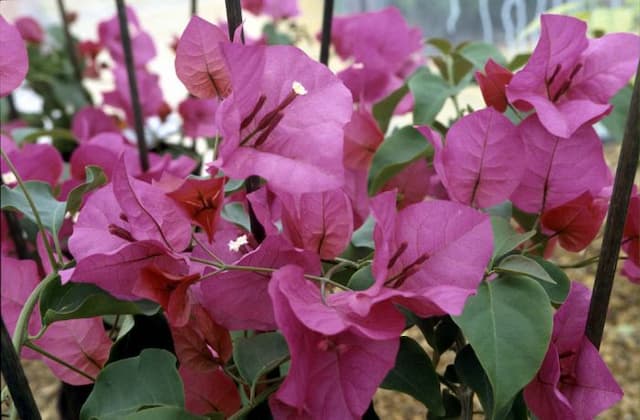
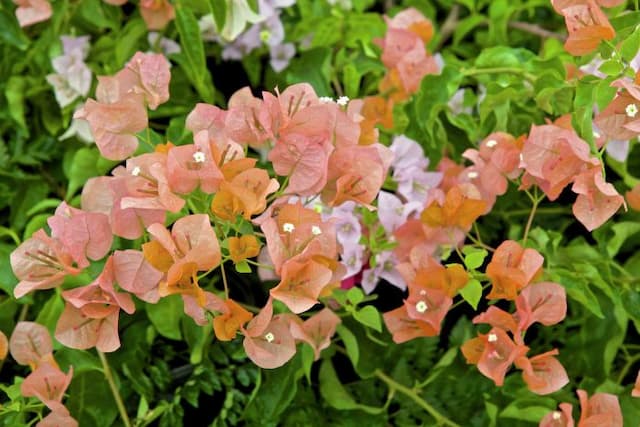
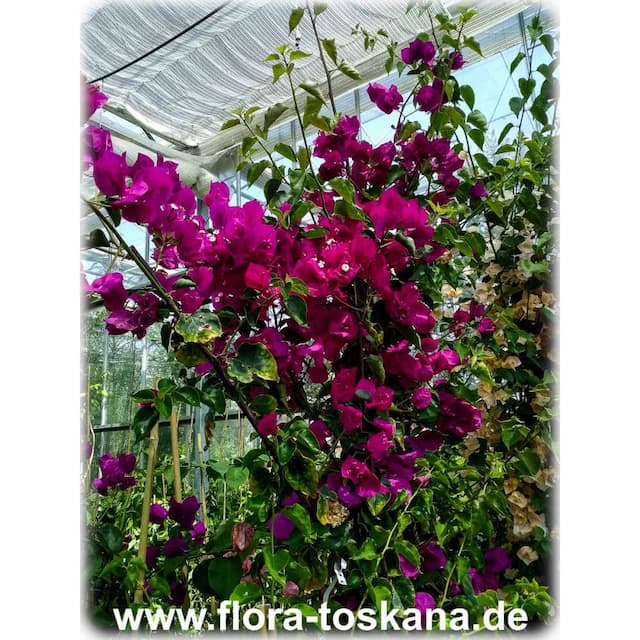
![Bougainvillea [Texas Dawn]](/_next/image?url=https%3A%2F%2Fplants-admin.emdemapps.com%2Fimages%2Fplants%2F%2Fimages%2F604b5f2598081.png&w=640&q=75)
